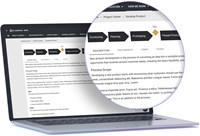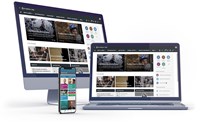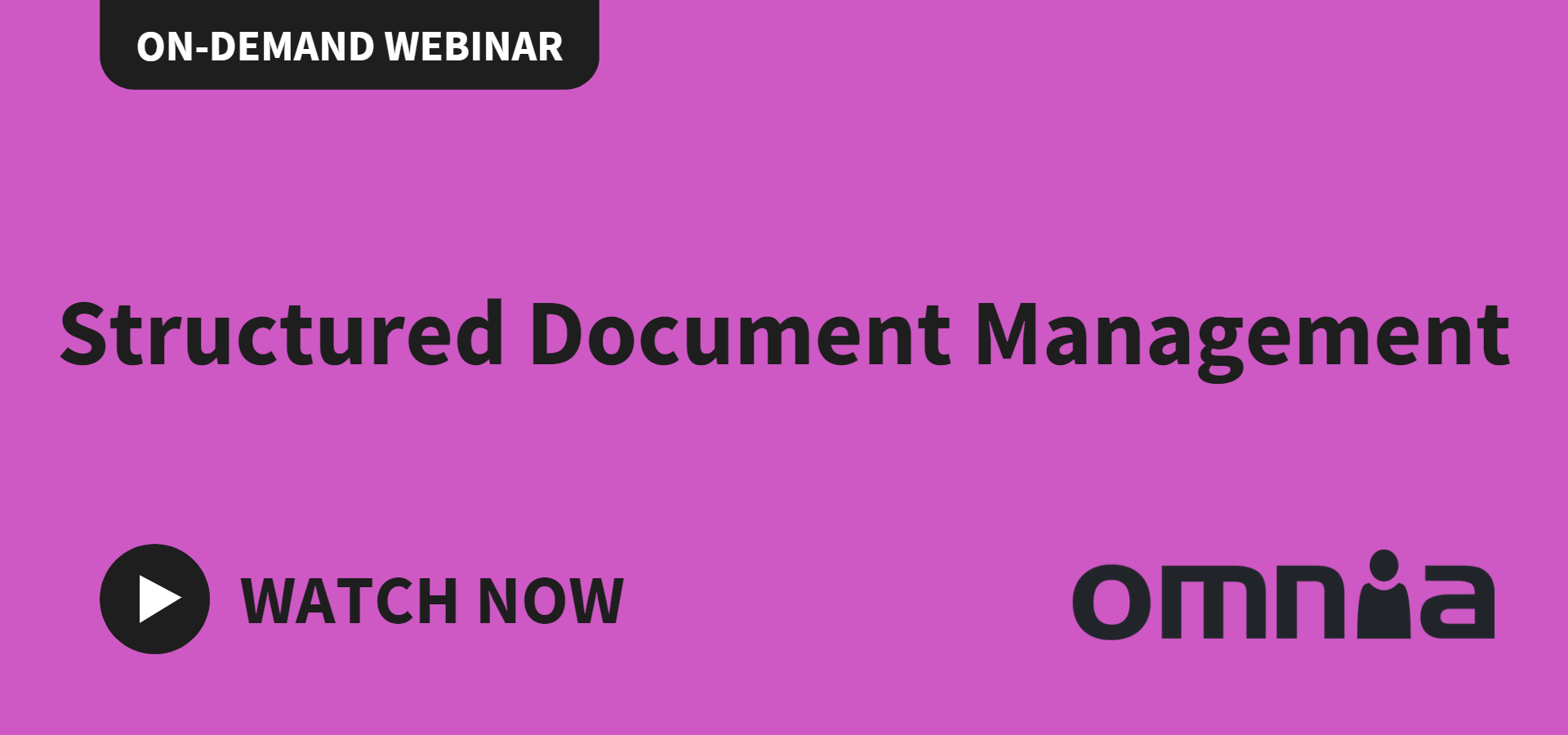What is a digital workplace?
A digital workplace is a set of software applications and tools employees use to complete tasks and activities. A digital workplace offers personalized, role-based services and collaboration tools to help employees do their best work – anywhere, anytime, using multiple devices.

Why do you need a digital workplace?
- Attract and retain talent. Today, knowledge workers expect a level of digital engagement and reject jobs that do not offer a flexible and hybrid work model.
- Boost efficiency and productivity. With easier access to information, organizational processes are executed more efficiently and with more agility using automation.
- Improve knowledge sharing and collaborations. Employees share knowledge and collaborate across the organization more efficiently using digital tools compared to the traditional workplace model.
Don't miss our on-demand webinars about intranets and the digital workplace
What is a digital workplace strategy?
To develop a successful digital workplace strategy, organizations must first find out how the employees would prefer to work. A company’s culture ultimately determines to what extent the employees will make use of the digital workplace and how it will improve organizational performance.
A digital workplace strategy should cover four areas:
- Employees. Building a digital workplace should help employees work more efficiently and communicate and collaborate with less effort. The goal is to enhance employee experience, helping them build relationships and enable greater knowledge-sharing.
- Technology. Organizations already use digital tools and applications such as email, desktop applications and much more. These tools must support how employees do their jobs and their need for flexibility in the modern workplace.
- Controls. Corporate governance and management processes are needed to keep the digital workplace updated, robust, secure, and healthy. The flow of information must also comply with your organization’s policies and industry regulations.
- Objectives. Any corporate investment requires goals and objectives. Your digital workplace vision must align with your business objectives and the organization's needs and preferences. Gather employee input and feedback before you start outlining your digital workplace framework.
Key benefits of a modern digital workplace
A digital workplace brings a multitude of advantages to an organization. With a digital workplace, you can:
- Boost efficiency and productivity. Many routine or more sophisticated processes can be automated or use AI features to eliminate more costly, time-consuming manual work. Employees get their job done faster and with fewer errors.
- Improve information findability and quality. Having information and documents accessible in one place reduces the time and effort users spend searching for stuff. Management tools for projects and processes improve quality control and productivity. Digitized processes and information reduce errors while enhancing transparency and knowledge-sharing.
- Increase employee satisfaction, flexibility, and scalability. A digital workplace offers employees greater flexibility to work where and when they can be most productive. This will often boost employee satisfaction and retention. It also offers an organization increased flexibility to scale growth or adapt to unexpected business disruptions.
- Greater transparency and cohesion. When information is unified and more easily accessible, it creates “a single version of the truth.” Unnecessary misinterpretations and bad decisions based on inaccurate information can be prevented. Organizational cohesion will strengthen when everyone has access to the same information simultaneously.
- Attract talent. A digital workplace can help those employees who value work-life balance, hybrid or remote work model. Today's employees are well-versed in cloud computing, social media, and other online collaboration applications. Organizations must embrace modern digital workplace tools to acquire and retain employees to maintain a competitive edge.
- Reduce overhead. With a complete virtual, digital workplace, organizations can cut down on travel expenses, office rent, and other costs that come with the traditional office model.
- Improve the bottom line. A digital workplace business model leads to various cost savings. It also empowers an organization to improve processes, learning, innovation and development, sales, and time-to-market. As a result, overall profit performance can be improved.
INDUSTRY REPORT
Top-ranked intranet – 7 years in a row!
ClearBox Consulting just released the 2024 Intranet and Employee Experience Platforms Report. Learn why Omnia is top of the table in the High Value Zone – leading all other intranets in an analysis of price to performance. Download a free copy of the report today.


How to create a digital workplace.
A digital workplace essentially combines three key elements: technology, processes, and culture. The framework of the digital workplace must embrace all these elements. Here is a roadmap for creating a successful digital workplace could look like this:
Define the current state.
Identify the organization’s current processes, tools, and ways of working. Find out how employees would prefer to work and how the digital workplace can support these needs.
Engage internal stakeholders.
Source the digital workplace project team from all core aspects of the organization. Beyond IT, Human Resources will play a key role. Determine how a digital workplace supports contact with customers and external parties.
Align with your goals.
Build a strategy with clearly defined objectives in line with your organization’s vision. Identify how the digital workplace will support corporate values, improve employee satisfaction, and more.
Choose the right platform.
Implement the platform and tools to deliver a unified user experience, strengthen organizational cohesion, and meet your goals and needs.
Find a catalyst for change.
It’s always hard for people to change their working methods and adopt new technologies. Establish change management processes to support the adoption of a new digital experience.
Continuous improvement.
Conduct regular employee surveys and set up automated reports on user behaviour. This will help assess employee adoption of the digital workplace and how it can be improved.
See Omnia in action
Discover how Omnia can help your organization drive employee engagement.
Learn how Omnia can help your organization improve internal communication, productivity, and employee engagement.
You will hear from intranet industry leaders with years of experience and thoughtful insights during the demonstration.
What are the components of a digital workplace?
The toolbox for building a successful digital workplace can be divided into eight categories:
- Productivity: Applications supporting employees to execute their tasks efficiently, such as desktop applications like Microsoft Word, Excel, PowerPoint, etc.
- Business applications: Online or on-premises solutions like ERP, HR systems, Management Systems, and CRM.
- Communication: Applications enable management and employees to publish, distribute and share information like an intranet, email, blogs, and information-specific portals.
- Collaboration: Solutions supporting efficient internal collaborations that are easy to manage and collaborate on and share information, plans, and files. These solutions include communities, team and collaboration areas, online meetings, wikis, and enterprise social media apps.
- Messaging: Applications providing rapid communication like chat/instant messaging platforms, mobile messaging, and micro-blogging.
- Connectivity: Solutions that help employees quickly find and contact experts and colleagues across the organization, such as employee directories, personal profiles, and organization charts.
- Knowledge & Innovation: Solutions enabling the organization to gather and share knowledge and to pull feedback and ideas from the employees to drive improvements and innovation, such as knowledge bases and communities, FAQs, polling, and survey applications.
- Mobility: Tools and applications enabling the employees to work anywhere, like tablets, smartphones, laptops, remote scanners, VPN networks, responsive intranets, and intranets accessible via native mobile apps, etc.
Challenges of a digital workplace.
The challenges encountered when implementing a digital workplace vary from one company
or organization to the other. It depends on the industry and line of work, the organization's size,
and whether it stretches beyond national borders and culture. Some of the most common challenges are:
Resistance to change.
Changing behaviours is difficult. It takes time to learn new tools. Businesses need to embrace change and show employees how the digital workplace, with smart tools, can help employees solve everyday tasks more efficiently.
Digital skill gaps.
The expected results will fail if the employees don’t know how to take full advantage of all the new tools. Adequate training on employee terms is critical to the success of the digital workplace.
Migration from legacy systems.
It’s often difficult to break free from legacy systems. Some try to implement the new platform without changing their existing processes. This will cause confusion and most likely create multiple data silos.
Security.
Implementing a modern digital workplace often means moving more data into the cloud. As a result, data security becomes paramount. Implementing a standardized platform with all the necessary security functions, guidelines, and processes is the best way to overcome this challenge.
Information overload.
A digital workplace usually has more information, documents, content, and files that swell over time. To avoid counter-productive amassing of information, you must establish lean digital information management routines. Ensuring that search functions maintain high performance is a priority.
Organizational silos.
A digital workplace can be a positive force to unite and bring the organization closer together. But to make this happen, organizational silos must be removed. This can be met with resistance, impeding employees from communicating and collaborating efficiently.
See Omnia in action
Discover how Omnia can help your organization drive employee engagement.
Learn how Omnia can help your organization improve internal communication, productivity, and employee engagement.
You will hear from intranet industry leaders with years of experience and thoughtful insights during the demonstration.
More Frequently Asked Questions.
What is digital transformation in the workplace?
Digital transformation in the workplace is defined as the integration of digital technology into practically all areas of an organization's processes, fundamentally impacting operations and how value is created. Digital transformation is also a matter of cultural change as it requires organizations to transform their ways of thinking and working. It also challenges old habits and long-standing business processes and explores new practices, ideas and innovations.
What is a Digital Employee Experience (DEX)?
A relatively new acronym in the HR and IT people’s jargon is “DEX.” It’s short for Digital Employee Experience, which describes an employer’s technology's impact on the employee. If, for instance, the IT environment is perceived as challenging to navigate, cluttered with hard-to-use tools, offers poor search options, and is supported by an invisible IT team, chances are your DEX is not great. However, the DEX index is probably very high if the employees feel comfortable with the tools provided, can easily find any information or other resources, and rarely have any problems with the technology.
By measuring your organization’s DEX index over time and taking action to improve it, you will see a rise in productivity, collaboration, engagement, employee satisfaction and retention.
How can you improve your digital workplace?
The development of a digital workplace is never complete. When you have implemented a new or modernized digital workplace, you can’t put your feet up. You have only moved on to the next phase, governance and continuous improvement.
Continuous improvement is vital for a sustainable and prosperous digital workplace. Create governance policies and establish and follow up on performance metrics aligned with your digital workplace strategy. Conduct regular employee surveys and set up automated reports on user behaviour to understand their adoption and what can be improved. Ensure that staff responsible for governance have representation from all parts of the organization to cover all aspects of the user experience.
What is Omnia?
Omnia is a modern and flexible Microsoft 365 and SharePoint-based intranet-in-a-box solution. It comprises leading-edge tools for communication, collaboration and governance, which help companies and organizations improve internal communication, collaboration and knowledge-sharing.
Why choose Omnia to support your digital workplace?
Omnia is an award-winning intranet platform that delivers leading performance and an intuitive, personalized, and task-oriented user experience on all devices. Its fully featured intranet capabilities cater to simple and complex publishing scenarios and ensure that content is constantly fresh and accurate and that users stay updated. In addition to a wide range of features, Omnia includes functionality and support for Document Management Systems, coupled with a process visualization tool (Process Viewer).
Omnia’s rich social features, like its smart templates and wizards for creating communities, can support an organization in strengthening its workplace cohesion and boosting knowledge-sharing and employee engagement. Omnia’s integration capabilities also enable smooth integration with internal and external applications, providing users with a unified digital workplace experience.
With Omnia, a company or an organization can consolidate and integrate its entire information archive, documents, processes, collaborations, and tools in one place. With a single entry point, organizations achieve a “single version of the truth” for their documents. This will boost productivity and employee engagement.
Explore how Omnia can help you!
Want to rejuvenate your employee engagement but don’t know where to start? Would you like to learn more about Omnia or schedule a product demo? Contact us, we’re here to help!




